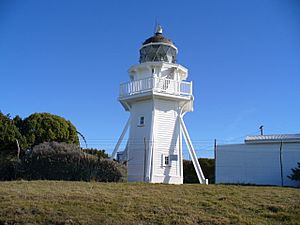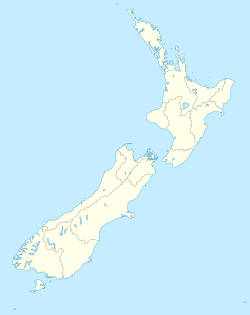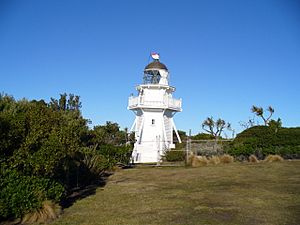Katiki Point Lighthouse facts for kids
 |
|
|
|
|
| Location | Katiki Point South Island New Zealand |
|---|---|
| Coordinates | 45°23′30.7″S 170°51′58.2″E / 45.391861°S 170.866167°E |
| Year first constructed | 1878 |
| Year first lit | 1878 |
| Automated | 1975 |
| Construction | wooden tower |
| Tower shape | hexagonal tower with balcony and lantern |
| Markings / pattern | white tower, red trim, black lantern |
| Height | 8 metres (26 ft) |
| Focal height | 58 metres (190 ft). |
| Current lens | light-emitting diode |
| Range | 10 nautical miles (19 km; 12 mi) |
| Characteristic | Fl W 12s. |
| Admiralty number | K4360 |
| NGA number | 5368 |
| ARLHS number | NZL-034 |
The Katiki Point Lighthouse, also called the Moeraki Lighthouse, first lit up in 1878. It was built to help ships avoid dangerous rocks near Katiki Point in New Zealand. This made the sea much safer for vessels heading to Port Chalmers in Dunedin. The lighthouse stands on the tip of the Moeraki Peninsula, between the towns of Moeraki and Katiki.
Contents
History of Katiki Point Lighthouse
This area has seen many shipwrecks over time. An old story tells of an ancestral canoe, a waka atua, that crashed here. It was returning from Hawaiki, and some of its cargo ended up on the beach. People believe these remains are the famous Moeraki Boulders you can see today.
Building the Lighthouse
The lighthouse was almost ready to shine for the first time. But a big storm hit, shaking the tower so much that the lamp's glass broke. A new glass had to be ordered, and the tower was made stronger. Finally, the light was switched on for the first time on 22 April 1878.
How the Lighthouse Works
The lighthouse tower is made of wood and stands 26 feet (8 m) (about 8 meters) tall. Its light is 190 feet (58 m) (about 58 meters) above sea level. The light flashes on for 6 seconds, then off for 6 seconds. Ships can see this light from up to 10 nautical miles (20 km) (about 18.5 kilometers) away.
Powering the Light
Today, the lighthouse uses a special light-emitting diode (LED) beacon. It gets its power from the main electricity supply. There's also a battery ready to take over if the main power goes out. The original lamp used a powerful 1000-watt bulb. It was also powered by electricity, with a diesel generator as a backup. You can still see this old lens inside the lantern room at the top of the tower.
Modern Lighthouse Operations
In 1975, the Katiki Point Lighthouse became fully automatic. This meant that the lighthouse keeper, who used to live and work there, was no longer needed. Now, computers and staff from Maritime New Zealand in Wellington watch over the light. They make sure it's always working correctly. The lighthouse was given a full restoration by Maritime New Zealand in 2006, keeping it in great shape.



